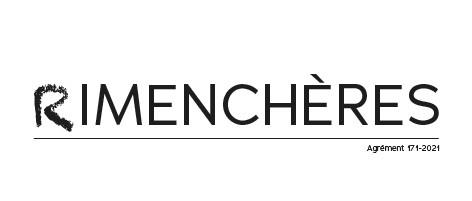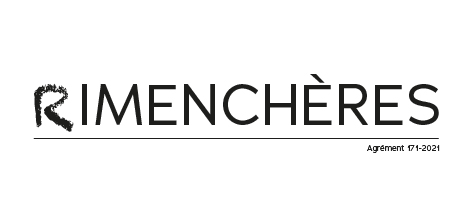La vente sera faite au comptant et conduite en Euros (€).
Les acquéreurs paieront, en sus des enchères des frais de 25% HT (TVA 20%) incluant les frais de Drouot Digital (1.5%TTC).
GARANTIES
Conformément à la loi, les indications portées au catalogue engagent la responsabilité de la SAS RIM ENCHERES et de son expert, compte tenu des rectifications annoncées au moment de la présentation de l’objet portées au procès-verbal de la vente. Les attributions ont été établies compte tenu des connaissances scientifiques et artistiques à la date de la vente.
Tous les lots sont visibles sur demande à l’étude, et durant les expositions publiques. Les reproductions au catalogue des œuvres sont aussi fidèles que possible, une différence de coloris ou de tons est néanmoins possible. Les dimensions ne sont données qu’à titre indicatif. L’état de conservation des œuvres n'est pas toujours précisé. L’absence de précisions ne signifie pas que le lot est en bon état. Lorsque l’état est précisé cela n’est fait qu’à titre indicatif. Rien ne remplace l'examen des lots par l'acquéreur. Cependant nous nous tenons à la disposition des acquéreurs potentiels pour leur communiquer des photos complémentaires, vidéos et/ou rapports de conditions afin qu’ils puissent constituer leur propre opinion. Des restaurations ou accidents peuvent ne pas être visibles sur les photos communiquées. Il ne sera admis aucune réclamation concernant d’éventuelles restaurations ou accidents une fois l’adjudication prononcée. Les rapports de conditions demandés à la SAS RIM ENCHERES et à l’expert avant la vente sont donnés à titre indicatif. Ils n’engagent nullement leurs responsabilités et ne pourront être à l’origine d’une réclamation juridique. L’adjudicataire sera le plus offrant et dernier enchérisseur et aura pour obligation de remettre ses nom et adresse.
Les images sont propriété exclusive de la SAS RIM ENCHERES. Toute reproduction ou diffusion nécessite une autorisation écrite de la Maison de Vente.
Le texte en français est le texte officiel qui sera retenu en cas de litige. Les descriptions en anglais ne sont données qu’à titre indicatif et ne pourront être à l’origine d’une réclamation.
ENCHERES
Les ventes aux enchères en ligne sont effectuées sur le site Internet « www.drouot.com », qui constitue une plateforme technique permettant de participer à distance par voie électronique aux ventes aux enchères publiques. L’utilisateur souhaitant participer à une vente aux enchères en ligne via la plateforme Drouot Online doit prendre connaissance et accepter, sans réserve, les conditions d’utilisation de cette plateforme (consultables sur www.drouot.com), qui sont indépendantes et s’ajoutent aux présentes conditions générales de vente. Il doit par conséquent s’inscrire avant le début de la vente sur la plateforme et fournir les pièces justificatives demandées. La SAS RIM ENCHERES a la possibilité d’accepter ou de refuser les inscrits ; leur participation sera confirmée avant la vente.
Les enchères : L’adjudicataire sera le plus offrant et dernier enchérisseur inscrit et enregistré au préalable auprès de Drouot. Tout enchérisseur est censé enchérir pour son propre compte et est tenu pour seul responsable de l’enchère. Aucune modification ne pourra être faite après la vente. Dans l’hypothèse où un prix de réserve aurait été stipulé par le vendeur, RIM SAS ENCHERES se réserve de porter des enchères pour le compte du vendeur jusqu’à ce que le prix de réserve soit atteint. Le prix de réserve ne pourra pas dépasser l’estimation basse figurant dans le catalogue ou modifiée publiquement avant la vente.
En portant une enchère, les enchérisseurs assument la responsabilité personnelle de régler le prix d’adjudication, augmenté des frais à la charge de l’acheteur et de tous impôts ou taxes exigibles. Sauf convention écrite avec la SASRIM ENCHERES, préalable à la vente, mentionnant que l’enchérisseur agit comme mandataire d’un tiers identifié et agrée par la SAS RIM ENCHERES, l’enchérisseur est réputé agir en son nom propre. Nous rappelons à nos vendeurs qu’il est interdit d’enchérir directement sur les lots leur appartenant. En cas de double enchère reconnue effective par le commissaire- priseur lié à un dysfonctionnement éventuel de la plateforme le lot sera remis en vente, tous les amateurs présents pouvant concourir à cette deuxième mise en adjudication.
La société SAS RIM ENCHERES ne saurait être tenue pour responsable d'un dysfonctionnement de la plateforme ou d'une interruption de connexion au cours d'une vente de nature à empêcher un acheteur d’enchérir.
RETRAIT DES ACHATS
Les lots seront à enlever sur rendez-vous, une fois le paiement encaissé.
Il est conseillé aux adjudicataires de procéder à un enlèvement de leurs lots par le transporteur de leur choix dans les meilleurs délais afin d’éviter ces frais de magasinage qui sont à régler avant l’enlèvement.
Le magasinage n’entraîne pas la responsabilité du commissaire-priseur ni de l’expert à quelque titre que ce soit. Dès l’adjudication, l’objet sera sous l’entière responsabilité de l’adjudicataire. L’acquéreur sera lui-même chargé de faire assurer ses acquisitions, et la SAS RIM ENCHERES décline toute responsabilité quant aux dommages que l’objet pourrait encourir, et ceci dès l’adjudication prononcée.
Les lots seront délivrés à l’acquéreur en personne ou au tiers à qui il aura confié une procuration originale et une copie de sa pièce d’identité.
REGLEMENT DES ACHATS
Nous recommandons vivement aux acheteurs de nous régler par carte bancaire ou par virement bancaire.
Conformément à l’article L.321-14 du code du commerce, un bien adjugé ne peut être délivré à l’acheteur que lorsque la société en a perçu le prix ou lorsque toute garantie lui a été donnée sur le paiement du prix par l’acquéreur.
Moyens de paiement légaux acceptés par la comptabilité :
• Espèces : (article L.112-6 ; article L.112-8 et article L.112-8 al 2 du code monétaire et financier)
· Jusqu’à 1 000 €
· Ou jusqu’à 10 000 € pour les particuliers qui ont leur domicile fiscal à l’étranger (sur présentation de passeport)
Conformément à l’article L.321-14 du code du commerce, un bien adjugé ne peut être délivré à l’acheteur que lorsque la société en a perçu le règlement de la part de l’acquéreur.
• Paiement en ligne (jusqu’à 10 000 €) sur
https ://www.rim-encheres.com/paiement-en-ligne
• Carte bancaire : une commission de 1.1% TTC sera perçue pour tous les règlements > 50 000 €. Pour les cartes étrangères, des frais supplémentaires de 1,5% du montant payé peuvent s’appliquer.
• Nous n’acceptons pas les cartes American Express.
• Virement : du montant exact de la facture, provenant du compte de l’acheteur, et indiquant le numéro de la facture. Les frais bancaires ne sont pas à la charge de l’étude. Pour un virement en provenance d’un pays hors de l’Europe, des frais de 15 € forfaitaires par paiement peuvent s’appliquer en sus du montant de la facture.
Banque Crédit du Nord, 9 boulevard des Italiens 75009 Paris
Titulaire du compte : RIM ENCHERES SAS
Code banque : 30076 - Agence : 02021
Numéro de compte : 42920000200 - Clé RIB : 36
Code Banque 30788 – Code guichet 00900
IBAN : FR76 3007 6020 2142 9200 0020 036
BIC : NORDFRPP
• les chèques ne sont pas acceptés.
DEFAUT DE PAIEMENT
Les règlements sont comptant.
La SAS RIM ENCHERES réclamera à l’adjudicataire défaillant des intérêts au taux légal majoré de 5 points et le remboursement des coûts supplémentaires engagés par sa défaillance, avec un minimum de 500€, incluant en cas de revente sur folle enchère :
- la différence entre son prix d’adjudication et le prix d’adjudication obtenu lors de la revente
- les coûts générés par ces nouvelles enchères
COMPETENCES LEGISLATIVE ET JURIDICTIONNELLE
Conformément à la loi, il est précisé que toutes les actions en responsabilité civile engagées à l’occasion des prisées et des ventes volontaires et judiciaires de meuble aux enchères publiques se prescrivent par cinq ans à compter de l’adjudication ou de la prisée. La loi française seule régit les présentes conditions générales d’achat. Toute contestation relative à leur existence, leur validité, leur opposabilité à tout enchérisseur et acquéreur, et à leur exécution sera tranchée par le tribunal compétent du ressort de Paris (France).
Si un client estime ne pas avoir reçu de réponse satisfaisante, il lui est conseillé de contacter directement, et en priorité, l’étude à l’adresse info@rimencheres.com.


